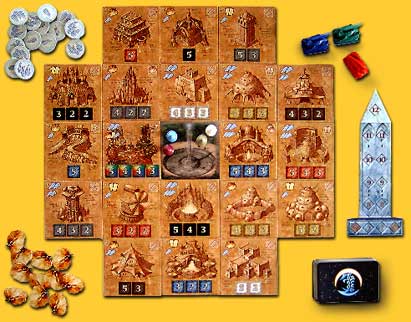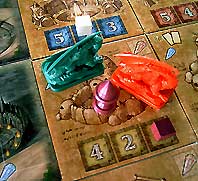Blue Moon City
Author: Reiner Knizia
Publisher: Kosmos
Year: 2006
review by

| x |
|
|
|
|
|
|
|
|
|
|
|
|
|
|
|
|
|
|
|
|
|
|
|
|
|
|
 |
A lot seems to have happened, and it wasn’t all that good! At the start of Blue Moon City the various people are left with the remains of a demolished city that they, optimists as they are, are determined to rebuild, occasionally assisted with the aide of moulting dragons. The reward for the completion of a building mainly exists of crystals, that the faithful tribes offer to their god Blue Moon. The player who is first to have offered a by the participating players preset amount, has won the game. |
| x |
|
|
|
|
|
|
|
|
|
|
|
|
|
|
|
|
|
|
|
|
|
|
|
|
|
|
| The playing field consists of 21 tiles that are laid out in a large cross around the central market place. On these tiles the sketches of the buildings to be rebuild are depicted, together with the building conditions. These conditions come in colours and values from two to five; the playing cards come in the same colours and values from one to three. The playing cards are the various people and their strength that the players control, together with the dragons on some of the cards. At the start of the game the players get eigth cards; a player may play as many cards as he wants, but may only draw two new cards at the end of his turn. |
 |
| x |
|
|
|
|
|
|
|
|
|
|
|
|
|
|
|
|
|
|
|
|
|
|
|
|
|
|

|
In a turn a player first moves his pawn one or two tiles, or leaves it where it is. After that he can play cards for an extra move, and move the dragons, again with the necessary cards. Then he can choose to play cards to participate in the rebuilding of the building on the tile that his pawn is on. If this condition is met, that is, if he has played the colour and up to the value depicted on one of the coloured squares, he may place a cube on that square. For every dragon on the tile the player gets one dragon scale. |
|
| x |
|
|
|
|
|
|
|
|
|
|
|
|
|
|
|
|
|
|
|
|
|
|
|
|
|
|
| These dragon scales trigger a special scoring when the last one has been taken from the stock pile. The player with the most scales gets six crystals, every other player with at least three scales gets three crystals. Any player with less than three crystals do not score but may keep their scales, the other players have to return theirs to the stock pile. |
|
| x |
|
|
|
|
|
|
|
|
|
|
|
|
|
|
|
|
|
|
|
|
|
|
|
|
|
|
|
|
|
When every building square on a tile is occupied by a players cube, the building is finished. All players involved get their reward in crystals; the player that has the most cubes on the tile gets an extra reward; this information all can be found on the tiles. The tile gets flipped to its completed side and the building can be admired in al its splendor. |
| x |
|
|
|
|
|
|
|
|
|
|
|
|
|
|
|
|
|
|
|
|
|
|
|
|
|
|
| On this completed side one or more symbols depict a bonus that can be earned for every participant in the completion of a neighboring tile; this bonus gets paid out at the completion of the building in concern. |
|
|
| x |
|
|
|
|
|
|
|
|
|
|
|
|
|
|
|
|
|
|
|
|
|
|
|
|
|
|
| x |
|
|
|
|
|
|
|
|
|
|
|
|
|
|
|
|
|
|
|
|
|
|
|
|
|
|
 |
|
|
|
|
|
|
|
|
|
|
|
|
|
|
|
|
|
|
|
|
|
|
 |
|
|
|
|
|
|
|
|
|
|
|
|
|
|
|
|
|
|
|
|
|
|
 |
|
|
|
|
|
|
|
|
|
|
|
|
|
|
|
|
|
|
|
|
|
|
| x |
|
|
|
|
|
|
|
|
|
|
|
|
|
|
|
|
|
|
|
|
|
|
|
|
|
|
 |
|
|
|
|
|
|
|
|
|
|
|
|
|
|
|
|
 |
|
|
|
|
|
|
|
|
|
|
|
|
|
|
|
|